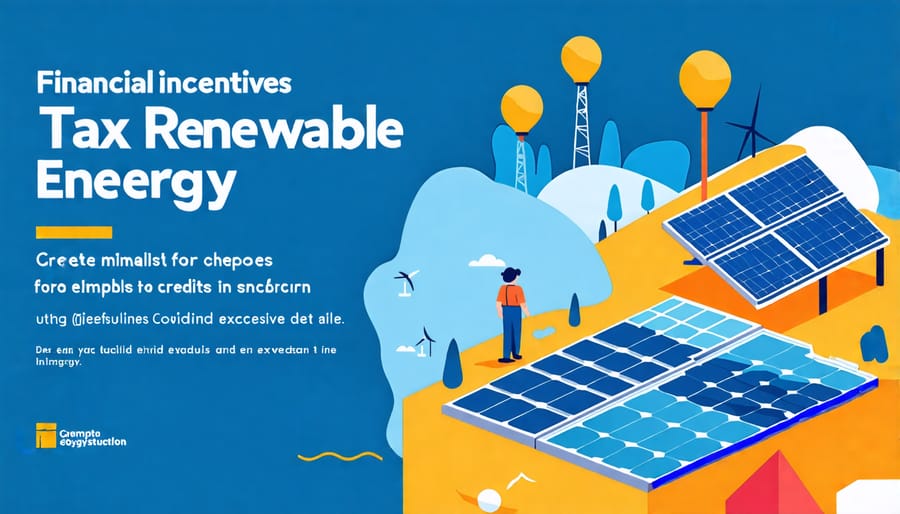Prioritize implementing incentive programs that reduce upfront costs of renewable technologies in construction projects. Streamline permitting processes to accelerate the integration of solar, wind, and other renewables in new developments. Incorporate renewable energy benchmarks into building codes to ensure compliance and drive innovation within the industry. Position collaborative frameworks between government and private sectors to facilitate knowledge sharing and the adoption of best practices for sustainable construction.
The Current Landscape of Energy Policies
Global Energy Policy Trends
Global energy policy trends increasingly emphasize the integration of renewable energy into various sectors, notably construction. Policymakers worldwide are adopting measures to bolster renewable energy use through subsidies, tax incentives, and regulatory frameworks that encourage sustainable practices. In the construction industry, this translates to mandates for green building certifications and the integration of solar panels, wind turbines, and energy-efficient materials into new developments. For instance, the European Union’s commitment to carbon neutrality by 2050 has led to stringent energy performance standards for buildings, significantly influencing construction designs and practices.
Countries like the United States and China are also setting ambitious targets to increase their share of renewable energy, with policies encouraging innovation and research in construction technologies. Additionally, collaborations between governments and private sectors are fostering an environment where renewable integration becomes a core component of project planning and execution. As construction professionals, understanding these global policy trends ensures not only compliance but also competitive advantage in an evolving market.

Impact on Construction Industry
Energy policies promoting renewable-energy resources are significantly reshaping the construction industry by driving changes in design and building practices. These policies encourage the integration of sustainable technologies, such as solar panels and geothermal systems, into both new and existing structures. In response, industry professionals are adopting innovative strategies to meet new regulatory standards for energy efficiency and sustainability. A critical element is the focus on reducing building emissions, which is leading to the increased use of green building materials and techniques. These changes have sparked a transformation in architectural design principles, with a growing emphasis on energy modeling and life-cycle analysis. Expert interviews reveal that architects and engineers are now prioritizing energy-efficient designs, which not only comply with regulations but also deliver long-term cost savings. In-depth case studies further illustrate how this shift is fostering collaboration across disciplines, as construction and design teams work closely to incorporate cutting-edge renewable technologies, thereby paving the way for greener, more sustainable urban developments.
Prominent Policies Promoting Renewable Resources
Incentive Programs and Tax Credits
Financial incentives and tax credits are crucial components of energy policies, significantly impacting the adoption of renewable resources in construction projects. These incentives are designed to offset the initial costs of integrating renewable technologies, such as solar panels and wind turbines, making projects more economically viable. Tax credits, such as the Investment Tax Credit (ITC), allow construction professionals to deduct a substantial percentage of the installation costs from federal taxes, effectively lowering the barrier to entry for renewable technologies. Furthermore, programs like accelerated depreciation under the Modified Accelerated Cost Recovery System (MACRS) enable businesses to recover renewable plant costs more swiftly, promoting quicker adoption. State-specific incentives, ranging from grants to rebates, also play a pivotal role, as they can vary widely and offer additional financial benefits for projects pursuing an energy-efficient home. By leveraging these financial tools, industry decision-makers can not only improve project sustainability but also enhance long-term cost savings, driving the widespread implementation of renewable technologies in construction.

Regulatory Frameworks and Legislation
Regulatory frameworks and legislation play a pivotal role in driving the adoption of renewable-energy resources in construction. Key regulations, such as the Renewable Portfolio Standards (RPS), mandate that specific percentages of energy consumption come from renewable resources, influencing new building projects to incorporate solar panels, wind turbines, and other green technologies. The Energy Independence and Security Act (EISA) emphasizes higher energy efficiency and increased renewable fuel production, also impacting construction designs to include zero-energy buildings and sustainable materials.
Moreover, the International Code Council (ICC) provides green building standards through codes like the International Green Construction Code (IgCC), which sets baseline requirements for sustainable construction practices. State and local incentives, including tax credits and grants, further motivate developers to utilize renewable sources in projects. For instance, California’s Title 24 energy standards offer a model for integrating renewable systems in construction planning.
Understanding these regulations ensures that architects and project managers not only comply with legal requirements but also capitalize on financial benefits, leading to more sustainable and energy-efficient building practices. Engaging with expert interviews and exploring in-depth case studies can provide valuable insights into navigating these complex frameworks effectively.
Case Studies: Successful Implementations
Case Study 1: The Eco-City Initiative
The Eco-City Initiative exemplifies an integration of forward-thinking energy policies and advanced construction techniques to create a model of urban sustainability. Located in a rapidly developing region, the initiative leverages governmental renewable energy mandates to transform traditional city planning. At its core, this project integrates solar photovoltaic units, wind turbines, and geothermal energy systems, collectively supplying over 70% of its energy needs.
Key to its success was a policy framework that incentivized the adoption of green technologies. Rigorous building codes mandated energy-efficient designs and materials, significantly reducing the carbon footprint. By employing energy-saving building envelopes and state-of-the-art HVAC systems, the Eco-City achieved an unprecedented balance of energy efficiency and architectural innovation.
Construction professionals involved in this initiative noted how these policies enabled collaboration among architects, engineers, and project managers, fostering an environment that prioritized sustainability from blueprint to execution. In addition, government subsidies for renewable installations reduced initial financial burdens, encouraging investment and accelerating implementation.
The Eco-City Initiative demonstrates the pivotal role of strategic policy in advancing renewable energy integration within urban environments. It serves as an inspiring blueprint for industry stakeholders aiming to meet both ecological and economic objectives, highlighting how cohesive planning can lead to impactful, sustainable outcomes.
Case Study 2: A Green Skyscraper in Metropolis
The Metropolis Green Skyscraper stands as an exemplar of how strategic energy policies can foster the adoption of renewable-energy solutions in high-rise construction. Supported by local government incentives, the project integrates cutting-edge technologies, significantly enhancing its environmental profile. The building’s façade incorporates photovoltaic panels, seamlessly blending aesthetic design with functionality to generate on-site solar power. Additionally, wind turbines mounted at higher elevations capitalize on urban wind patterns, further reducing reliance on non-renewable energy sources.
The city’s policy framework offers subsidies for renewable installations and expedited permit processes, making it economically viable for developers to invest in sustainable technologies. Interviews with the project’s lead architect reveal that these incentives not only mitigate initial costs but also engender innovation in renewable energy applications. The building’s advanced energy management system, which optimizes the power grid interaction and reduces consumption peaks, is a product of such policy-driven innovation.
Moreover, the skyscraper employs a rainwater harvesting system complemented by a greywater recycling plant, illustrating a holistic approach to sustainability. This case study underscores the impact of well-crafted energy policies on transforming urban architecture, offering a blueprint for similarly ambitious projects globally. By integrating policy support with technological innovations, Metropolis sets a precedent for future developments aiming to balance economic and environmental priorities effectively.
Challenges and Barriers to Policy Implementation
Economic and Technical Hurdles
The push for renewable energy in construction faces significant economic and technical barriers. Financially, the high initial costs of investing in solar panels, wind turbines, and other renewable technologies pose a challenge for developers and builders. Despite decreasing costs over the past decade, renewable energy projects still require substantial upfront capital, often leading to reluctance in adopting these technologies without assured long-term returns. Moreover, government incentives, while beneficial, are often inconsistent, making financial planning complex for long-term projects.
On the technical side, integrating renewable technologies into existing infrastructure demands advanced engineering solutions. For instance, retrofitting older buildings to accommodate solar or wind systems can be technically complex and costly. Furthermore, renewable energy sources like wind and solar are intermittent, necessitating advancements in energy storage and grid stability to ensure reliable power supply. Addressing these barriers requires collaborative efforts among policymakers, engineers, and industry leaders to foster innovation and investment in new technologies. Building a robust framework to overcome these hurdles is crucial for ensuring the sustainable growth of renewable energy in the construction industry.
Regulatory and Political Challenges
Navigating the regulatory and political landscape presents significant challenges for policies aimed at increasing the adoption of renewable energy in the construction sector. Despite widespread recognition of the environmental and economic benefits, inconsistencies in regulatory frameworks can hinder the integration of renewable technologies. Construction professionals often face layers of local, state, and federal regulations, each with distinct requirements that complicate compliance and project timelines. Political fluctuations also play a critical role; changes in government priorities can lead to uncertainty and fluctuating incentive programs, impacting long-term planning for architects and engineers.
In addition, the existing infrastructure often lacks the capacity to fully support renewable energy integration, from grid connectivity issues to inadequate energy storage solutions. For industry decision-makers and project managers, these infrastructural gaps necessitate investments that can escalate project costs—a consideration not always addressed by policy incentives. Thus, aligning regulatory measures with practical implementation strategies is vital to overcoming these hurdles and fostering an environment where renewable energy can thrive in construction. Through expert insights and case studies, industry leaders can explore viable solutions to these challenges, promoting a more sustainable future.
The Future of Construction with Renewable Policies
Emerging Technologies and Innovations
Emerging technologies continuously reshape how renewable energy policies are crafted and implemented within the construction industry. Innovations in solar cell efficiency, energy storage, and smart grid technology drive policy shifts that accommodate these advancements. For instance, the integration of building-integrated photovoltaics (BIPV) allows construction professionals to transform traditional materials into energy-generating surfaces, fostering policies that incentivize such green technologies. Moreover, as the industry undergoes a digital transformation, technologies like AI and IoT are pivotal, enabling smarter energy management systems which align with new policy frameworks emphasizing sustainability. Expert insights suggest that embracing these innovations in conjunction with supportive policies can reduce operational costs while enhancing energy efficiency. An in-depth examination of successful case studies reveals that clear guidelines and financial incentives for implementing these technologies can significantly accelerate the transition to renewable resources in construction. As the industry evolves, continued collaboration between policymakers and industry leaders will be essential in harnessing the full potential of emerging technologies, ensuring they meet regulatory standards and sustainability goals.
Potential Policy Developments
As global commitment to sustainability grows, energy policies are expected to evolve significantly, promoting renewable energy adoption across industries, including construction. Future policies will likely incentivize the deployment of advanced materials and technologies that integrate seamlessly with sustainable design. By encouraging the uptake of innovative solutions, these policies will enable construction professionals to harness the future of architecture, utilizing solar, wind, and geothermal resources.
Furthermore, emerging carbon compliance standards will drive firms toward achieving net-zero emissions in their projects. These expected policy developments aim to foster an environment that prioritizes energy efficiency and resilience, offering fiscal incentives, regulatory support, and streamlined approval processes. In-depth analysis of how these policies impact construction practices reveals potential shifts in project funding, design, and implementation strategies, demanding a proactive approach from industry practitioners. By anticipating these changes, construction professionals and decision-makers can better align their projects with the evolving regulatory landscape, ensuring sustainable practices remain at the forefront of architectural innovation.

Conclusion
In conclusion, as the construction industry continues to evolve, the adoption of strategic energy policies that promote the use of renewable resources becomes increasingly critical. Through expert interviews and detailed case studies, we’ve seen firsthand the transformative power these policies can have. They not only contribute to reducing the carbon footprint of construction projects but also promote innovation and enhance operational efficiencies among stakeholders including architects, engineers, and project managers.
These policies lay the groundwork for integrating advanced technologies and sustainable practices, driving the industry towards a greener future. Key examples have illustrated that when construction professionals are equipped with the right knowledge and resources, they can significantly increase the use of renewable energy in their projects. Moreover, strategic energy policies provide a competitive advantage by aligning environmental responsibility with economic gains, ensuring long-term sustainability and resilience.
It’s imperative that industry decision-makers actively engage with policymakers to create a coherent framework that supports renewable energy initiatives. By fostering collaboration and commitment across all levels of the construction process, we can achieve a more sustainable, energy-efficient construction landscape. Ultimately, strategic energy policies are not just beneficial but essential for meeting the current environmental challenges and building a more sustainable future for generations to come.

